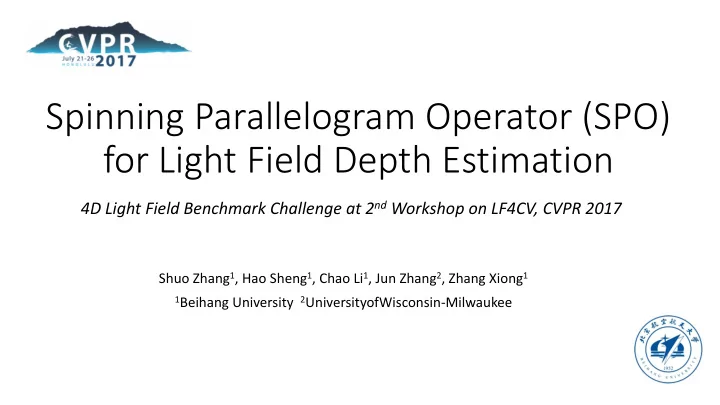

Spinning Parallelogram Operator (SPO) for Light Field Depth Estimation 4D Light Field Benchmark Challenge at 2 nd Workshop on LF4CV, CVPR 2017 Shuo Zhang 1 , Hao Sheng 1 , Chao Li 1 , Jun Zhang 2 , Zhang Xiong 1 1 Beihang University 2 UniversityofWisconsin-Milwaukee
� Method Comparisons • SPO vs. Stereo Matching Method SPO Stereo Matching Theory: • Locate lines in Epipolar Plane • Locate points in sub-aperture Images (EPIs) images • By maximizing the distribution • By minimizing the matching distances of separated regions. cost Volume: • Histogram Distance: • Absolute Difference 𝜓 " = $ ( ' 𝑗 − ℎ ' 𝑗 ) " • Square Difference • Gradient Difference ' 𝑗 + ℎ ' 𝑗 • …… . Involved • Surrounding points • Reference matching points 9 (.,:) 67 8 Pixels: 𝑥 ' 𝑗, 𝑘 = 𝑑 𝑒 ' 𝑗, 𝑘 𝑓 "; 9 • Horizontal and vertical views • All views Occlusions: • Broken lines in EPIs • Mismatching points • Multiple local maximum • Large matching cost at the distances correct depth label
Benchmark Results Comparisons § Occluded Regions
Benchmark Results Comparisons § Occluded Regions Reason 1: SPO for Local Estimation - The histogram distance is robust to occlusions, which keeps at a local maximum value for the occluded points.
Benchmark Results Comparisons § Occluded Regions Reason 2: Cost Integration - The local volumes from different EPIs are integrated based on the confidence: F/7 HIJ 𝑑 = 𝑓 6 7 , where 𝑒 <,= 𝑦, 𝑧, 𝜄 = 𝑑 A,= ∗ (𝑦, 𝑣 ∗ ) 𝑒 A,= ∗ 𝑦, 𝑣 ∗ , 𝜄 + 𝑑 D,< ∗ (𝑧, 𝑤 ∗ ) 𝑒 D,< ∗ 𝑧, 𝑤 ∗ , 𝜄 "K 9 Local depth map Local depth map Local depth map from vertical EPI combining two EPIs from horizontal EPI
Benchmark Results Comparisons § Occluded Regions Reason 3: Cost Filtering - The effective information is propagated to surrounding similar points using the guided filter, where the occluded points are recovered more accurately. Local depth map Final depth map Local cost volume Filtered cost volume
Benchmark Results Comparisons § Noisy Regions - The histogram distance is influenced by the size of the bins, where the bins with large size are robust to noise; number of bins 64 32 16 ü number of bins: the smaller the better
Benchmark Results Comparisons § Low-texture Regions - The histogram with small bins is able to deal with low texture regions; number of bins 64 128 ü number of bins: the larger the better
Benchmark Results Comparisons § Surface reconstruction: - Only the guided filter is used for the distance volume, where - Small radius -> noisy depth map - Large radius -> over-smooth depth map radius = 3 radius = 9
Implementation • Procedure: 1. Construct histogram image in different bins; 2. SPO -> Convolution kernel; 3. Add up the histogram distance in different bins; • Analyses: • Images: B bins, N channels and D depth label • NBD convolution operations for each pixel • Time: • Matlab, Intel i7 3.60 GHz CPU and 8 GB RAM • 328*328 images, 64 labels, 64 number of bins : 65s (local estimation), 63s (guided filter)
Summary • Strengths: • Fine structure • Histogram distance • Discontinuities, robust to occlusion • Maximum response • Adapt to noisy and low-texture images • Surrounding points • No requirement for depth scope and angular • No occlusion modeling resolution • Simple and effective Algorithm • Drawbacks: • Simple optimization • Unreliable Surface Reconstruction • Surrounding points • Maximum accuracy: Badpix (0.01) is high
Reference • Paper • Shuo Zhang, Hao Sheng, Chao Li, Jun Zhang and Zhang Xiong, Robust Depth Estimation for Light Field via Spinning Parallelogram Operator, Computer Vision and Image Understanding, 2016, 145(C), 148-159 • Benchmark Results & Code • https://github.com/shuozh/Spinning-Parallelogram-Operator • Contact • shuo zhang (shuo.zhang@buaa.edu.cn) Thank you!
Recommend
More recommend